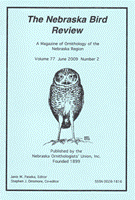Nebraska Ornithologists' Union
Date of this Version
9-2006
Document Type
Article
Citation
Sidle, Jobman & Faanes, "Aerial Searches for Whooping Cranes along the Platte River, Nebraska," from Nebraska Bird Review (September 2006) 74(3).
Abstract
The endangered Whooping Cranes (Grus americana) that migrate between Wood Buffalo National Park, Alberta and Northwest Territories, and the Aransas National Wildlife Refuge Area, Texas, roost at many aquatic stopover locations (Austin and Richert 2001) including the central Platte River, Nebraska (Johnson 1982; Lingle et al. 1984, 1986, 1991; Faanes et al. 1992; Richert 1999). Under the U.S. Endangered Species Act, 90 km of the central Platte have been designated as critical habitat for the Whooping Crane, although suitable Platte River habitat for Whooping Crane and Sandhill Crane (Grus canadensis) continues to decline (Sidle et al. 1989, Currier 1997). The Whooping Crane has a long history of using the Platte River, and public agencies and private organizations have endeavored to learn more about Whooping Crane roost sites to enhance conservation of the species through regulatory and other efforts (Sidle et al. 1990a; Faanes 1992; Faanes and Bowman 1992; Ziewitz 1992). On the average, about 7% of the Whooping Cranes use the central Platte River as a stopover during migration (National Research Council 2005). Here we describe our aerial survey technique to locate roosting Whooping Cranes.
Knowing the locations of Whooping Cranes roosting on the Platte River is necessary to improve our understanding of crane distribution and habitat characteristics of roost sites on the river. Records of roosting Whooping Cranes have largely relied upon observations reported by the public to government agencies or conservation organizations. There has been a need, however, for a more consistent, objective method of determining roost site locations. One methodical approach to locate Whooping Cranes is to fly in a light aircraft along the Platte River at dawn or dusk. At dawn, the birds are close to leaving the roost to migrate north or south, or to feed in adjacent wet meadows and croplands. At dusk, the birds may be just arriving from meadows and cropland. Whether at dawn or dusk, there is a narrow window to visually detect roosting Whooping Cranes.


Comments
Copyright 2006, Nebraska Ornithologists' Union. Used by permission.